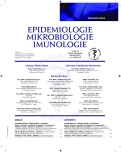Natural antibodies against α(1,3) galactosyl epitope in the serum of cancer patients
Authors:
M. Hamanová 1; L. Zdražilová Dubská 2; D. Valík 2; J. Lokaj 3
Authors‘ workplace:
BioVendor – Laboratorní medicína, a. s., Brno
1; Masarykův onkologický ústav, Oddělení laboratorní medicíny, Brno
2; Ústav klinické imunologie a alergologie, Lékařská fakulta MU, Brno
3
Published in:
Epidemiol. Mikrobiol. Imunol. 63, 2014, č. 2, s. 130-133
Category:
Review articles, original papers, case report
Overview
Background:
Natural antibodies against saccharide antigens are found in the human serum; most of them are directed against α-galactosyl epitope (Galα1-3Galβ1-4GlcNAc-R). Experimental and initial clinical studies show the potential for use of anti-galactosyl antibodies in the immunotherapy of cancer patients with glycolipids containing the α-galactosyl epitope. This therapeutic approach is based on the presence of these antibodies in the serum of cancer patients. Only scarce literature data is available on the incidence of these antibodies in cancer patients. Data is lacking on their amounts and isotype characteristics in different types of cancer.
Material and methods:
An ELISA test with a polyacrylamide-conjugated synthetic disaccharide, Galα1-3Galβ, has been designed for quantitative detection of anti-galactosyl IgM, IgG, and IgA antibody isotypes. This test was used to screen the sera from 57 patients with breast, colorectal, or panceatic cancer or malignant melanoma and from 145 healthy controls.
Results:
The serum concentration of anti-galactosyl antibodies (anti-Gal) is gender dependent: anti-Gal IgM antibodies are present in higher titres in healthy women than in healthy men (p < 0.01). Patients with breast, colorectal, or pancreatic cancer or malignant melanoma had comparable serum levels of anti-Gal IgM, IgG, and IgA antibody isotypes to healthy controls. Male patients with colorectal cancer had higher anti-Gal IgA antibodies than healthy men (p< 0.01).
Conclusion:
Comparable concentrations and isotypes of anti-galactosyl antibodies are found in the serum of cancer patients and healthy controls.
Keywords:
alpha(1,3) galactosyl epitope – natural antibodies – anti-Gal – ELISA – cancer immunotherapy
Sources
1. Waldmann TA. Immunotherapy: past, present and future. Nature Med, 2003;9:269–277.
2. Galili U, LeTemple DC. Natural anti-Gal antibody as a universal augmenter of autologous tumor vaccine immunogenicity. Immunology Today, 1997;18(6):281–285.
3. Tönder O, Natvig JB, Matre R. Antibodies in human sera to rabbit erythrocytes. Immunology, 1967;12:629–637.
4. Galili U, Rachmilewitz EA, Peleg A, Flechner I. A unique natural human IgG antibody with anti-α-galactosyl specificity. J exp Med, 1984;160:1519–1531.
5. Galili U. Anti-Gal: an abundant human natural antibody of multiplepathogeneses and clinical benefits. Immunology, 2013;140:1–11.
6. Galili U. Evolution and pathophysiology of the human natural anti-Gal antipody. Springer Semin Immunopathol, 1993;15:155–171.
7. Castronovo V, Colin C, Parent B, Foidart JM, Mahieu P. Possible role of human anti-gal antibodies in the natural antitumor defense system. J Natl Cancer Inst, 1989;81:212-216.
8. Galili U, Wigglesworth K, Abdel-Motal UM. Intratumoral injection of α-gal glycolipids induces xenograft – like destruction and conversion of lesions into endogenous vaccines. J Immunol, 2007;178:4676–4687.
9. Tremont-Lukas IW, Avila JL, Hernandez D, Vasquez J, Teixeira GM, Rajas M. Antibody levels against alpha-galactosyl epitopes in sera of patients with squamous intraepithelial lesions and early invasive cervical carcinoma. Gynecol Oncol, 1997;64:207–212.
10. Larkin JMG, Norsworthy PJ, A’Hern RP, Eisen TG, Gore ME, Porter CD. Anti-αGal- dependent complement-mediated cytotoxicity in metastatic melanoma. Melanoma Res, 2006;16:157–163.
11. Markiewski MM, Lambris JD. Is complement good or bad for cancer patients? A new perspective on an old dilema. Trends Immunol, 2009;30:286–292.
12. Fishelson Z, Donin E, Zell S, Schultz S, Kirschfink M. Obstacles to cancer immunotherapy: expression of membrane complement regulatory proteins (mCRPs) in tumors. Mol Immunol, 2003;40:109–123.
13. Hellrung DJ, Kisselev S, Link CJ. Co-expression of [alpha] (1,3) galactosyltransferase and Bacillus thurigiensis PIPLC enhances hyperacute rejection of tumor cells. Cancer. Immunol Immunother, 2007;56:25–35.
14. Manches O, Plumas J, Lui G, Chaperot L, Molens JP, Sotto JJ, Bensa JJ, Galili U. Anti-Gal mediated targeting of human B-lymphoma cells to antigen-presenting cells: a potential method for immunotherapy using autologous tumor cells. Haematologica, 2005;90:625–634.
15. Rossi GR, Mantino MR, Unfer RC, Seregina TM, Vahanian N, Link CJ. Effective treatment of preexisting melanoma with whole cell vaccines expressing α(1,3)-galactosyl epitopes. Cancer Res, 2005;65:10555–10561.
16. Itzkowitz SH, Yuan M, Ferell LD, Palekar A, Kim YS. Cancer-associated alterations of blood group antigen expression in human colorectal polyps. Cancer Res, 1986;46:5976–5984.
17. Chen Z, Qiu X, Gu J. Immunoglobulin expression in non-lymphoid lineage and neoplastic cells. Amer J Pathol, 2009;174:1139–1148.
18. Sandrin MS, Vaughan HA, Xing PX, McKenzie IF. Natural human anti-Gal(1,3)Gal antibodies react with human mucin peptides. Glycoconj J, 1997;14:97–105.
19. Rossi GR, Unfer RC, Seregina T, Link CJ. Complete protection against melanoma in absence of autoimmune depigmentation after rejection of melanoma cells expressing α(1-3) galactosyl epitope Cancer. Immunol Immunother, 2005;54:999–1009.
20. Whalen GF, Sullivan M, Wasseff W, Galili U. Cancer immunotherapy by intratumoral injection of α-gal glycolipids. Anticancer Res, 2012;32:3861–3868.
Labels
Hygiene and epidemiology Medical virology Clinical microbiologyArticle was published in
Epidemiology, Microbiology, Immunology

2014 Issue 2
Most read in this issue
- A point prevalence survey of healthcare-associated infections in the Slovak Republic – a part of the EU project
- Candida dubliniensis in clinical specimens and possibilities for identification
- Q fever – an occupational disease leading to disability – case report
- Diagnosis of Clostridium difficile infections: Comparative study of two immuno enzyme assays with confirmation by PCR and culture followed by PCR ribotyping
